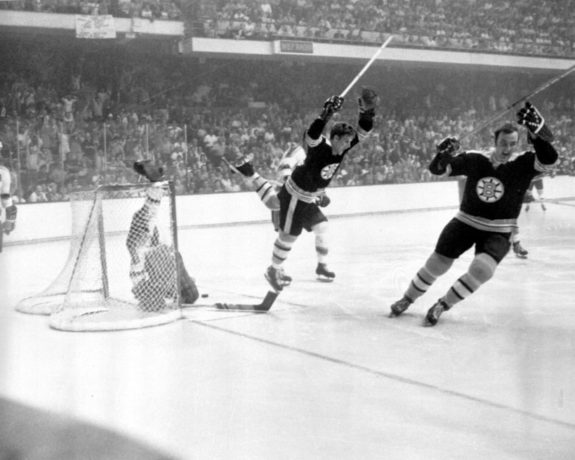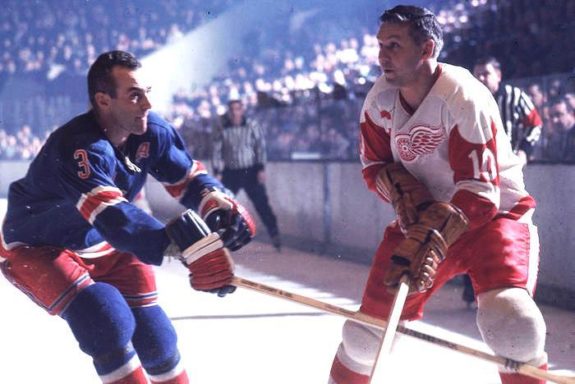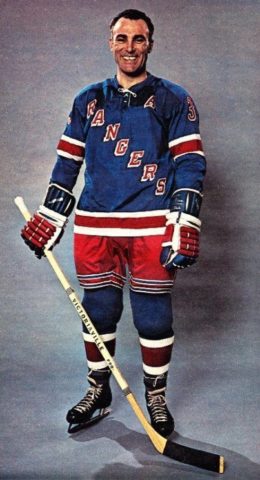As the NHL season approaches, it’s the perfect time to remember New York Rangers’ legend
His death brought great sadness to those who fondly remembered Howell as being a model of consistency for all 17 seasons he played in New York. Rangers team president Glen Sather’s official statement on the passing of Howell expressed those heartfelt sentiments shared by all.
Today, the New York Rangers and the hockey world are saddened to hear of the passing of Legendary Blueshirt, Harry Howell. One of the most iconic players in franchise history, Harry’s Hall of Fame accomplishments on the ice were exceeded only by the tremendous gentleman he was off the ice. I was privileged to have worked with Harry for over a decade in both Edmonton and New York and treasure our memories together. – Glen Sather
For those not familiar with Howell, let me give you a quick history lesson. First, he was the last stay-at-home defenseman to win the Norris Trophy before a man named Bobby Orr transformed the position. But more importantly, Howell was the on-ice mentor to the stars (Rod Gilbert, Vic Hadfield
Howell Last of a Dying Breed
The emergence of Bobby Orr ushered in a new era in the NHL which brought more offensive-minded players to the blue line. He revolutionized the sport by possessing a skill level to take the puck out of his own zone and move up ice effortlessly to finish the play by either scoring a goal or setting up a teammate with an excellent scoring chance.

Howell may have been clairvoyant about the future of the NHL. During his acceptance speech for the 1966-67 Norris Trophy, Howell boldly predicted that Orr would be collecting this award for the next decade, and he wasn’t too far off. Orr went on to win the Norris Trophy for the next eight consecutive seasons which firmly established him as hockey’s best defenseman. It was poetic justice that both men went into Hockey Hall Of Fame together in the Class of 1979. Still to Howell’s loyalists, no one defended his own end of the ice better than Harry the Horse.
1966-67 Season Was Special for Howell
If there was one season that stood out from the rest for Howell, it would be the 1966-67 season that culminated with him winning the Norris Trophy. Ranger fans who witnessed this extraordinary season will swear that Howell never made a defensive mistake clearing the puck out of the zone or defending a would-be scorer in front of the net.

What made the seven-time All-Star so special was his ability to position himself between a streaking winger and his goaltender. Howell would cut off the angle heading towards the net and force the opposing player to make a high-risk pass that could be easily picked off by a back-checking teammate. No defensemen executed the play as smoothly as Howell.
Howell’s Iconic Hockey Career
Howell made his NHL debut as a 19-year-old with the Blueshirts in 1952 and went on to play 24 seasons in the NHL and WHA. He appeared in 1,411 NHL games, but never was much of point producer, scoring 94 goals and 324 assists for his career.
As you skim through the list of Rangers team records, everyone is in agreement that it will be hard to surpass Howell’s record of 1,160 games played as a Ranger. It’s hard to imagine that he only missed 40 games during his entire career in New York. In fact, the mark is so cherished that the organization honored Howell with a ceremony for playing in his 1,000th
The lone disappointment in Howell’s career was how bad the Rangers were during his time in New York. The organization reached the Stanley Cup playoffs only seven times with Howell and in each appearance, the Rangers were eliminated in the first round. His only association with a Stanley Cup-winning team came as a scout for the 1990 Edmonton Oilers.
A back injury that occurred in the following season after winning the Norris Trophy seemed to slow down Howell’s effectiveness on the ice. Then Rangers general manager and coach Emile Francis tried to encouraged Howell to retire from hockey by offering him a front office position with the organization, but
Prior to the start of the 1969-70 season, Francis sold Howell’s contract to the Oakland Seals, where he played only one season before being traded to the Los Angeles Kings. After two seasons with the Kings, Howell continued his career in the WHL as he played three seasons with the New York Golden Blades, San Diego Mariners
How to Define a Team Legend

What cements a player’s legacy is having their number retired by an organization. It’s a symbol of their greatness, and Howell’s No. 3 hangs from the rafters inside Madison Square Garden. He is one of 10 former Rangers to have their number retired by the organization.
It was fitting that the Rangers bestowed this honor to Howell on the same night they retire Andy Bathgate’s No. 9 as well. The bond between Howell and Bathgate began as teammates playing junior hockey in Guelph, Ontario, and it continued together with the Rangers. Bathgate was a talented winger with a heavy slapshot as he recorded 272 goals (fourth all-time in Ranger history) in 12 seasons with the Blueshirts.
It doesn’t take long for a professional athlete to become a distant memory, but iconic stars have a way of overcoming this fate by holding a place in the hearts of an organization’s loyal fan base. We live in an era where everyone is more interested in identifying the “next big thing” rather than appreciating the talent playing in front of them each night. Often, we forget how proficient professional athletes are with their elite skills.
It’s important to take the time to salute the greatness that was Harry Howell because he was a true ambassador of the sport.